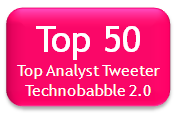 I am not a gamification expert. In fact, until today, I was skeptical of the potential effectiveness of the gamification of work in changing employee behavior and performance. I have consistently advised my software vendor clients that gamification is a wild card, because the value of gamifying enterprise software has not been demonstrated beyond question.
I am not a gamification expert. In fact, until today, I was skeptical of the potential effectiveness of the gamification of work in changing employee behavior and performance. I have consistently advised my software vendor clients that gamification is a wild card, because the value of gamifying enterprise software has not been demonstrated beyond question.
My outlook on gamification changed instantly today, while reading a New York Times Magazine article written by Charles Duhigg and shared on Twitter by Sameer Patel, whose value judgements and recommendations I very much trust. The article, which is actually an extended book excerpt, is not about gamification. Rather, it is about the application of analytics and behavioral science to large retailers’ marketing efforts. However, what I learned reading the article changed my perspective on the gamification of work by revealing a scientific basis for why it must succeed, if properly applied.
Duhigg tells the story of Target’s efforts to use customer purchase and demographic data to identify which of its female customers were in the second trimester of a pregnancy, so the retailer could shift those customers’ in-store and online buying habits. While that story is fascinating in itself, Duhigg’s explanation of the behavioral science on which retailers build their marketing strategies is what made me rethink my position on the gamification of work.
Behavioral scientists have shown that habits – routines that we largely perform subconsciously – are developed responses to a consistent, reoccurring stimulus. We repeat the action (habit) every time our brain is cued by the stimulus because doing so produces a mental, emotional, or physical reward. The more we repeat this cue-routine-reward loop, the further ingrained the habit becomes.
As Duhigg explains with an extended anecdote about Proctor & Gamble’s marketing efforts around its Febreze product, it is very difficult, if not impossible, to create a new habit in a vacuum. The only way to effectively change a habit is to embed it in an established cue-routine-reward loop, replacing the old routine with a new one. This is the scientific key to why the gamification of work is not just bogus theory.
For gamification to be effective, new behavioral routines must be applied when triggered by a specific work stimulus and yield already desired rewards. If we understand the cues that trigger unproductive habits for workers, as well as the rewards they derive from applying those routines, we can replace those unproductive actions with more productive ones.
Most examples of work gamification that I have seen ignore the existence of cues completely. Gamification elements are constantly present, rather than appearing only under specific conditions. Embed it and they will play.
Furthermore, gamification has too often been explained in terms of changing the rewards when, in fact, it is about changing the behaviors themselves. Behavioral science has demonstrated that changing the reward does not change the behavior. Rather, the routine must change, and the new, desired behavior must be linked to an existing, desired reward that motivates an employee.
Other Thoughts Related to This Behavioral Science
The behavioral science behind Target’s and P&G’s efforts to alter customer’s buying habits can be applied to any other situation in which change is desired to affect positive performance outcomes. Unproductive work habits is one area, as discussed above. Another is the adoption of new enterprise software.
If organizations tied usage of new software to the specific cues and rewards associated with existing work tasks and habits, adoption would rocket up the desired hockey-stick curve. Both the use cases and the benefits would be crystal clear to employees, eliminating two of the most significant barriers to the mainstream adoption of new software. The “what’s in it for me” would be immediately obvious to the workers to whom the new software has been launched. Change communication (and application training) would still be critical, but the creating the associated messages would be greatly simplified, as they are already known.
As demonstrated in Duhigg’s article, behavioral scientists (and retailers) also understand that there are a few specific, life-altering events that provide the perfect window in which influencers can change an individual’s seemingly intractable habits. Events such as graduating from college, changing employment, getting married, buying a house, and yes, having a baby, disrupt peoples’ ingrained habits, or at least cause them to question their routines. As such, major life events offer influencers a very valuable opportunity to seed new habits that will then remain in place and unquestioned until the next big life event occurs.
Why is that important? Think about who in the enterprise is currently responsible for being aware of impending or recent employee major life changes, and helping employees minimize the effects that those changes may have on their work performance. Human Resources. Yes, HR is the corporate custodian of changes associated with employee life-events. As such, they are well-positioned to identify the optimal opportunities for changing an individual employee’s work habits in ways that will lead to improved performance. Managers directly supervising one or more employees are even better positioned to identify those performance change opportunities, as they often become aware of actual or planned employee life changes before HR knows about them.
Charles Duhigg’s book excerpt provided me with an ah-ha moment regarding the gamification of work. It also underscored how important the understanding of behavioral science is to affecting positive workplace transformation. Many of us focused on the intersection of business and technology too often are unaware of, or under-value, the contributions that social science has made to the understanding of organizational behavior. Thank you Mr. Duhigg (and Mr. Patel) for leading me to these insights today.
Image source: http://www.bigdoor.com




